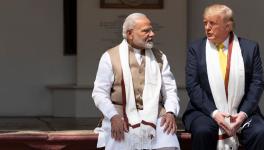Troubling Long-term Implications of India’s Response in Ladakh
Image is use for representational only. image courtesy: The Indian Express
Late last month, just before the two rounds of ministerial-level talks between the Indian and Chinese defence and foreign ministers respectively, the Indian Army occupied the heights along the Line of Actual Control (LAC) to the south of Pangong Tso in Ladakh. Though then advertised as a pre-emptive manoeuvre, designed to prevent additional Chinese grab of territory on the Indian side of the LAC, the remarkable military feat was meant to signal Indian resolve, thereby strengthening the hands of ministers when at the table with their Chinese counterparts.
In the event, the talks fizzled out and the Indian military is high and dry and on the heights. The foreign minister level discussion merely froze the status quo and set the stage for corps commander-level talks, which, as the foreign ministry later clarified, were meant to set the initial conditions for de-escalation. Notwithstanding their marathon-like duration, the corps commander-level talks threw up an agreement not to send in more forces to the front-lines in the interim, while further talks would tackle disengagement and de-escalation.
Meanwhile, India has been preparing to sustain troops in the upper reaches through the upcoming winter, in addition to the additional forces who were sent over the summer. This is a massive burden on the national exchequer, which is reeling under a laggard economy and COVID-19. Besides, the annual defence budgets having dipped over the past six years, the winter occupation of the heights is an enormous logistical challenge for the armed forces.
Most of the psychological impact on troops of being stationed at very high altitudes will only be fully understood in retrospect. For now, the media has reported that Chinese soldiers have been observed evacuating their comrades from the upper reaches on stretchers. However, schadenfreude is no way to evaluate the merits or demerits of a military operation.
It appears that the decision to occupy the heights south of Pangong Tso was propelled by a desire to fix the Chinese in place, facing Indian troops in close proximity, and overlooking their defences. This, it is perhaps assumed, would force the Chinese to bring concessions to the ministerial-level discussion table, or the follow-up military talks, for they would not (it is presumed) measure up to a long haul.
This assumption has it that Indian troops are no strangers to mountain warfare, have held very-high-altitude tenures and long endured the mountains and glaciers in Kargil and Siachen respectively. On the contrary, the thinking seems to have gone, the Chinese were supposedly conscripts, to whom the rigours of the mountains were unknown. The Indian side believes they would have to choose between staying put or agreeing to disengage and de-escalate, if not revert to the status quo ante.
The other competing explanation for India’s moves is relatively implausible: it has been advertised that the rush up the Kailash Range was meant to pre-empt a Chinese grab at territory. Fact is, China would not have waited four months if they had interest in occupying those features. It is possible the features are of growing interest to India’s neighbour, especially in the face of a steady build-up of Indian troops. However, the Indian build-up itself is likely to have stopped the Chinese from approaching those heights.
Satiated, and with an upper hand in the northern end of the confrontation line (the Depsang plains, where they posed a threat to the Indian outpost at Daulat Beg Oldie), and having pocketed the north bank of the Pangong Tso, the Chinese are unlikely to have been pondering a move south of the lake.
Indian information operations are therefore just that—a perception management exercise to sell the military operation as an Indian fight-back. No wonder some in the media described the action of securing the features as “capture”, hardly aware of the difference between the two military operations: to secure a feature and its capture. Now, the spin is that India has stared down the Chinese. This is at the cost of Indian occupation of the inhospitable heights indefinitely. “Won” at a considerable cost, these ranges will now have to be kept at a considerable cost too.
Quite contrary to Indian expectations, the Chinese appear to be firming in, digging in communication fibre optics and so on. By all accounts, their logistics chain is holding and does not appear stretched, as they do have the advantage of an easier terrain on the Tibetan plateau on their side of the LAC.
Therefore, the burden of measuring up to their own manoeuvres is on the Indian side, and, more importantly, it must work out, through talks, a way to staunch the “LC-isation” of the LAC. That is, the growing reference is to how LAC appears is morphing into the Line of Control (LC) in terms of troop deployment, alert and activity. LC is the name of the militarily active line that India shares with Pakistan in Jammu and Kashmir. Though the LC also contends with militant infiltration from the Pakistani side, nevertheless, there is a certain avoidable resemblance developing between the two lines.
While the deployment has advantages in projecting the Army as doing “something” in the face of loss of some 1,000 sq km to China, the continuing stand-off has long-term adverse implications that ought to have precluded India’s choice of deployment. India had two choices: offensive action such as a counter grab or localised eviction, or, the choice it made: seeing the Chinese off through talks. The latter has by now been revealed as vacuous. As for the first choice, the lack of Indian offensive action suggests a strategic deficit.
This is not the first time that the government, though voluble on being strong on defence, has flattered only to deceive—as in the surgical strikes. Yet, even when faced with a weaker opponent in Pakistan, India was quick to signal de-escalation. During the aerial surgical strike, it satisfied itself with a perception management exercise, claiming it had shot down an F-16, even in the face of contrary evidence.
Therefore, the Indian military settled for securing features, and, even here India alerted the Chinese to its soft underbelly to the south of Pangong Tso, which explains why China has attempted to strengthen itself there. India has presented this as evidence of Chinese ill-intent in the sector that in turn prompted India to dig in. In short, for political reasons, India pumped up its moves to mean more than warranted.
This is how India finds itself with little but the deployment in the higher reaches. Earlier demonstrated capacity at Siachen, where a brigade has been deployed, and Kargil, where it has a division in place, and Arunachal Pradesh, where two additional divisions were sent, does not automatically imply strategic good sense in Ladakh. It is questionable whether this particular military option—touted as mirror deployment—was at all necessary, given China had already digested what it had set out to.
The Indian Army thus confronts another manpower-guzzling operational engagement of indefinite duration. This will eat up any budget increases for modernisation, making the gap with the Chinese military even wider. It will also blunt India’s edge on the Pakistan front. As for a two-front capability, under the circumstance, it is best left waiting in the wings. Already, ideas are being aired on reconfiguration of Pakistan-centric, unused and unusable armour heavy forces. Even the Army’s Kashmir engagement may see a progressively increased presence of the police and paramilitary on the cutting edge of counter insurgency, thereby also heightening the suppressive template there. The infantry dominant nature of the task in mountains will see the continuing sway of the infantry over the army, thereby keeping it tied down to traditional moorings.
Politically, the right-wing regime is not averse to the situation since it staves off scrutiny over its inaction on the loss of Indian territory. It has effectively passed the buck to the military, which, through its actions south of Pangong Tso appears to have won the perception battle for it. In a way, the relative inaction, or lack of exercise of offensive options, has avoided a possible military loss that would have put paid to the Indian regime’s assiduously-cultivated muscular image. As it goes into the last stretch of the Bihar election campaign and gains momentum for the election battle in West Bengal thereafter, the Ladakh episode is sure to be on a back-burner.
Yet, since this is a long-term engagement, the military will be kept to the professional till with the responsibility of border management. Seen in relation to how this regime has approached other institutions—hollowing them out—the Army being preoccupied and out of the way would be spared the regime’s attention. It will also be politically marginalised, concentrating on an urgent and immediate mandate at the border. One cannot help but point out that in a democracy an apolitical military is the best, but when democracy itself is being progressively dismantled, the military’s role is moot. Nevertheless, under the circumstances on the northern border, where the potential for a two-front engagement remains, the military shall be otherwise engaged, even as the constitutional republic is transformed, quite in the political interests of the regime. This is the troubling long-term implication that has escaped attention so far.
The author is a freelance strategic analyst. The views are personal.
Get the latest reports & analysis with people's perspective on Protests, movements & deep analytical videos, discussions of the current affairs in your Telegram app. Subscribe to NewsClick's Telegram channel & get Real-Time updates on stories, as they get published on our website.
























